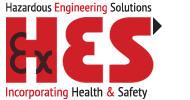
The digitalization of processes in hazardous areas places high demands on explosion protection. All infrastructure components used in these areas must be intrinsically safe or explosion-proof and certified. The Pepperl+Fuchs Group, a pioneer in the field of mobile devices for hazardous areas, meets these requirements with a comprehensive portfolio of certified solutions, from smartphones, tablets, and HMI systems to intrinsically safe barriers and remote I/O systems to Ethernet APL technology and sensor technology in hazardous areas.
Augmented reality for more efficient workflows
Augmented reality (AR) offers enormous potential at device level for digitalizing processes. With the help of this technology, information can be brought directly into the field of vision and display of employees in real time and presented in a spatially and context-sensitive manner. For example, markings on cables or flanges or process values can be displayed directly next to the corresponding valves.
AR therefore offers particularly great potential for complex tasks such as shutdown work, commissioning, or fault diagnosis in areas that are difficult to access. The technology is also ideal for training and qualifying new employees, for example in practical on-the-job training with AR-supported instructions or via remote support. In addition, AR overlays can be linked to digital twins of assets to simulate scenarios. This integration significantly improves the basis for decision-making, increases efficiency, and ensures safe plant operation.
5G as the basis for AR
The 5G mobile communication standard ideally complements augmented reality technology. In addition to the necessary bandwidth, 5G also provides the low latency required to transmit AR content in real time and integrate it seamlessly. On site, technicians receive context-sensitive instructions, overlay markings on components, and live data such as sensor values or histories directly in their field of vision. At the same time, they can request support or instructions from remote experts at any time, who can be easily connected.
This shifts maintenance processes more toward just-in-time assistance, reducing errors and increasing first-time fix rates. Planning is shifting organizationally toward data- and event-driven workflows, for example, when predictive maintenance alerts automatically trigger AR checklists. An integrative approach is crucial here. AR and 5G are not isolated solutions. They must be seamlessly connected to CMMS/ERP systems, asset digital twins, and role and rights models.
IT security in practice
The high demands placed on IT security require that it be considered from the outset in all digitalization initiatives. Today, this can be easily reconciled with intuitive and efficient operation, for example, using modern, explosion-proof smartphones and tablets from Pepperl+Fuchs. These devices feature integrated biometric authentication methods, such as fingerprint sensors or facial recognition, which ensure fast, user-friendly, and highly secure access.
This eliminates the need for time-consuming entry of complex passwords in everyday industrial use, without compromising security. Biometric identification ensures that only authorized persons have access to sensitive data, control functions, company networks, or applications. Together with encrypted communication and role-based access concepts, this creates a solution that not only successfully bridges the gap between maximum user-friendliness and maximum security but also ensures industrial processes are running smoothly.
Customers also benefit from the fact that Pepperl+Fuchs mobile devices are part of the Android Enterprise Recommended (AER) program. This guarantees consistent, easy deployment and management of mobile solutions through hardware and operating system support, as well as guaranteed security and operating system updates. The Samsung Knox mobile security solution also ensures a high level of device and data security for companies.
Connected workers—highly networked into the future
Intrinsically safe tablets and smartphones already serve as digital and networked hubs for connected workers. They enable authentication, collect sensor data, and bundle a wide variety of communication channels. They also allow for the seamless integration of mobile scanners, IoT gateways, or communication peripherals such as headsets. This makes them a central component for safe, efficient, and networked work processes in hazardous areas.
In the future, platforms for “digital shift operation” will emerge that digitally map handover protocols, know-how transfers, shift handovers, and shift KPIs, thus enabling comprehensive shift digitalization. Step by step, the connected worker is evolving into a highly networked, smart-supported employee who can access and respond to all relevant information, analysis tools, and expert knowledge securely and context-sensitively in real time at any time.
“As a pioneer, Pepperl+Fuchs is continuously working on developing intuitive solutions to optimally connect people in industrial environments, simplify work processes, and sustainably increase efficiency,” says Christopher Limbrunner, Team Lead Product Management of the Enterprise Mobility division at Pepperl+Fuchs. “In addition to providing the right hardware, we also support our customers in the holistic planning and implementation of the necessary infrastructure. They benefit from our many years of expertise and a global support and service network. This ensures that applications are not only compliant and reliable, but also efficient and future oriented.”










